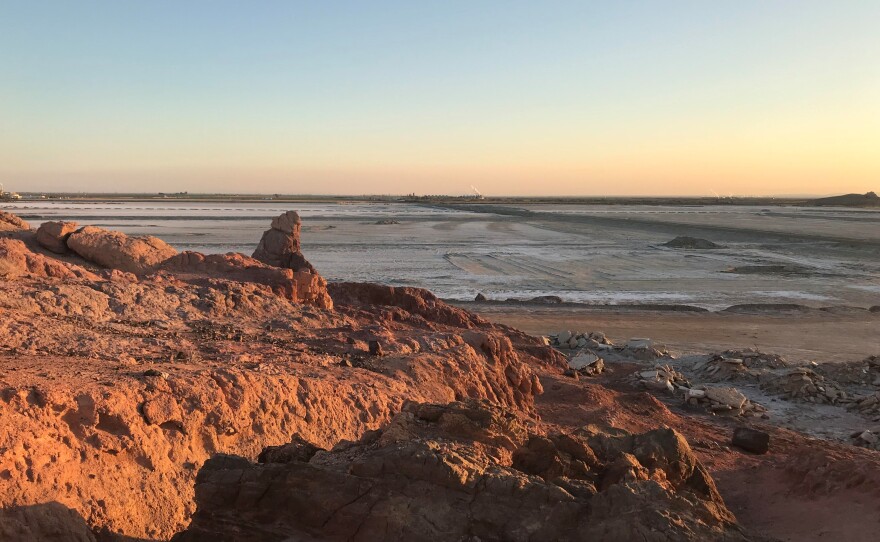Imperial Valley officials are reportedly close to finishing an important habitat restoration project at the Salton Sea.
The remake of Red Hill Bay was supposed to be a model for a management plan around the shrinking lake, but the effort is two years overdue and still months away from completion. The Salton Sea needs a management plan because water is evaporating faster than it’s being replaced, and that’s leaving large swaths of lakebed exposed to the elements.
“You got the Salton Sea probably a mile out there. Along the shoreline. You see the playa here,” said Bruce Wilcox, California Resources Agency Assistant Secretary of Salton Sea Policy.
RELATED: New Project Takes Aim At Controlling Salton Sea Dust
He is standing on a dry boat launch on the southeastern part of the 35-mile long lake and he is pointing at the shore several hundred yards away. This miles-wide southern portion of the lake is only a few feet deep.
The future means a smaller lake
“Most of that area I believe will be dry or close to it. You could probably almost walk across it now if it wasn’t so muddy,” Wilcox said.
Because the lake is so shallow here, any significant drop in overall lake levels exposes hundreds of acres of lakebed.
That newly dry land not only contains fine dust particles that can be picked up by the desert winds, local officials worry about pesticide residue from farm fields and other toxic materials from runoff.

The Salton Sea has long absorbed heavy metals, industrial waste and sewage-tainted flows from the New River, which flows north from Mexico. That is why covering the playa is so important.
California’s first step on a long-awaited plan to deal with the situation got such a warm welcome back in 2015. Biologists suggested flooding hundreds of acres of dry playa near Red Hill Bay. It would be easy they reasoned because the bay was flooded naturally as recently as a decade ago.
Turning it back into a saltwater bay creates habitat for birds while locking in the dust.
“Well from that berm there, a mile that way to the east will be all wet with water,” said Chris Schoneman, a biologist with the U.S. Fish and Wildlife Service.
Red Hill Bay Project considered a key
He points to a flat patch of land that is white, not from snow, but from salt leaching out of the ground. A bit of engineering and this becomes a 400-acre bay.
“Turn it into essentially a huge saltwater pond. Saltwater, not the same concentration of salt that the Salton Sea is in right now because we don’t want to rebuild the Salton Sea. Now we have an opportunity to restore the land using Salton Sea water but also agricultural irrigation water,” Schoneman said.
But the project, which is supposed to be the first of many, has been anything but easy. The $5 million project was supposed to be done two years ago, but likely won’t be complete until late summer. There was trouble ordering the barge and engineers learned some hard lessons about working on the dry lakebed.
“We’re working in very wet soils that look dry on the surface, but you start digging and the ground starts to literally liquefy as your big equipment is trying to do its work out there. Getting big bulldozers and excavators out there,” Schoneman said.
But the berms are finally built and ready to hold in the water that’ll be pumped in.

RELATED: Change At The Salton Sea Is Affecting Bird Populations
By the end of summer, barring unforeseen circumstances, Red Hill Bay will be a wide swath of shallow salty water.
“This will be a bug farm for the birds that come here expecting to find food and continue on their migration,” Schoneman said.
Once these saltwater ponds are complete, state officials can turn their attention to other areas of the exposed playa.
There is an added sense of urgency because the exposed lakebed can put up to 100 tons of fine dust into the air every day.
But the challenge presented by physically engineering a system of shallow ponds is only matched by the challenge of raising money to do the work.
California only has about half the $380 million for the Salton Sea management plan.
“As you know the Salton Sea plan is a 10-year plan but it doesn’t have the funds to be carried out,” said Robert Schettler of the Imperial Irrigation District.
Money is always an issue
The regional water and power company is working to make sure California keeps its commitment to manage the changing lake. That includes finding enough money.
“It was assured that the state of California would handle the restoration of the Salton Sea and here we are more than 15 years later and now the state has a plan it just doesn’t have enough money,” Schettler said.
IID is using its position as a senior water rights holder to push for federal matching funds for the project.
“None of this money comes to us, it is for the state projects to get built. And why because the people in the environment around it need it,” Schettler said.
The lake, meanwhile, continues to shrink. And California’s commitment to manage the Salton Sea’s changing environment still isn’t happening quickly enough to cover exposed lakebed.
That leaves open the possibility that a potential public health disaster becomes reality.
You can hear this story and other local news every morning by subscribing to San Diego Stories, KPBS’ daily news podcast. Subscribe via iTunes, Google Play or your favorite podcatcher.







